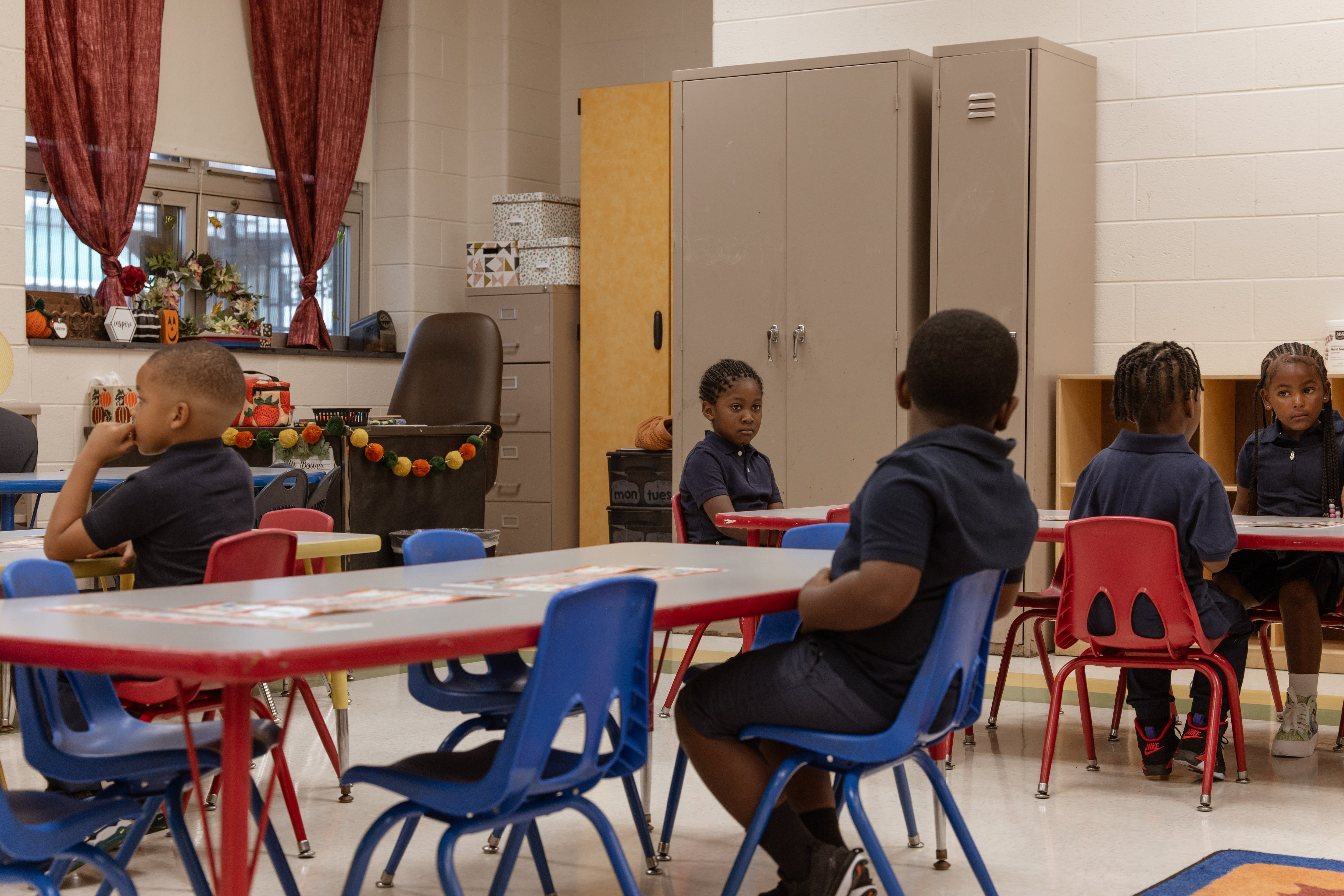Sign up for Chalkbeat Philadelphia’s free newsletter to keep up with the city’s public school system.
The long-awaited report from the state’s Basic Education Funding Commission recommends steady, annual increases in school spending, an overhaul to charter school funding, and a plan to calculate what it means to fund students “adequately.”
But even without any earth-shattering proposals, the report released Thursday did not receive unanimous support from the bipartisan but politically divided commission. And school funding experts are already raising questions about it.
The commission’s report follows months of hearings and hours of testimony from school leaders, education advocates, and others regarding how Pennsylvania should remake its school funding formula. A Commonwealth Court judge ruled the state’s funding formula unconstitutional in 2023 and ordered the state to revamp it. If lawmakers and Gov. Josh Shapiro enact the commission’s recommendations, Philadelphia students could receive significantly more funding — nearly $243 million more in the fiscal 2025 budget, for example, and $1.4 billion more over seven years.
In an 8-7 vote largely along party lines, the commission (which is made of Democratic and GOP legislators, as well as members of Shapiro’s administration) approved a 114-page report that includes eight recommendations. All votes in favor were Democratic lawmakers or from Shapiro’s team, while the Republicans were united in opposition. Sen. Lindsey Williams, a Democrat, voted no because in her view the report’s recommendations don’t go far enough.
Primary among those recommendations is to update estimates of what each district needs so all their students can succeed — the so-called “adequacy” target — by recalculating key aspects of the funding formula to make its annual allocations to districts more fair and predictable.
The commission also calls for making teacher salaries more competitive; adding funding for student supports, including mental health; and examining how the state can bolster support for access to prekindergarten, career and technical education, and funding for libraries.
To make sure that school spending in the state continues to be fair and adequate, it also wants the commission to be reconstituted in 2029 to provide continued monitoring of the funding system.
But overall, the commission’s recommendations regarding state funding fall well below the $6.2 billion over five years of increased education spending that some advocacy groups are calling for. Those groups want a $2.2 billion hike in fiscal 2025, followed by $1 billion increases in each of the following four years.
Instead, the commission determined that there’s a $5.4 billion funding adequacy gap, of which $291 million is “the local responsibility of low tax effort school districts.” The remaining $5.1 billion “rests upon the state” which Pennsylvania would close through a seven-year ramp-up in funding.
For 2023-24, Pennsylvania’s share of K-12 total spending in the Commonwealth is $10 billion.
The commission also acknowledged the widely disparate tax burdens for individual districts. To address this, it proposed an additional $955 million in state money, in the form of “tax equity supplements,” for districts that have been taxing themselves at high rates.
“I believe the report not only meets our obligation as a commission … but also meets constitutional muster as directed by the Commonwealth Court,” said state Rep. Mike Sturla, a Democrat and a majority chair of the commission.
But he cautioned, “really, this is the end of the beginning. There’s still a whole lot of work to do.”
Shapiro said in a Thursday statement he “look[s] forward to addressing these points when I deliver my budget to the Legislature in a few weeks, and to continue working with leaders in both parties in order to deliver a thorough and efficient public education for students across our Commonwealth.”
In a Thursday press conference after the report’s release, advocates who were among plaintiffs in the 2014 school funding lawsuit that was the subject of the Commonwealth Court judge’s ruling last year said it represented a step in the right direction. In particular, they highlighted the commission’s proposed adequacy targets that take into account the actual needs of Pennsylvania students, district by district.
“This is a big first step … the timeline is long, it’s not perfect, and there are unaddressed issues. But the vision it lays out is a transformative one,” said Dan Urevick-Ackelsberg of the Public Interest Law Center, which represented the plaintiffs along with the Education Law Center.
Recommendations focus on teacher workforce, poverty data, charters
The commission’s recommendations won’t go into effect without corresponding legislation approved by the state’s General Assembly and the governor. Its recommendations are:
- Simplify and “reduce the volatility” in the state’s basic education funding formula by using three-year averages of U.S. Census Bureau data on poverty and median household income. The state should then add at least an additional $200 million to this updated formula each year.
- Calculate adequacy targets — or how much each district should be spending on their student population, based on their needs. The commission recommended using Pennsylvania’s state performance standards to determine which districts are “successful” and then use those districts’ spending level as a target for all school districts.
- Invest more state money in school facilities, especially in districts like Philadelphia.
- Reexamine the way charter schools are funded in the state and “modernize” the calculation of cyber charter school tuition.
- Invest in the teacher workforce.
- Invest in student supports like mental health services and the “community schools” model.
- Bring back the Basic Education Funding Commission in 2029.
- “Consider other important education issues,” including access to pre-K, transportation, school safety, and “explore dedicated funding for every school district to have at least one school librarian.”
While saying that the state “should be investing in competitive teacher salaries across the Commonwealth,” the report cites a few actions already taken, including a teacher pipeline program and provides stipends and other incentives. But it doesn’t lay out a blueprint or funding source for helping high-poverty, low-spending districts raise their salaries, which generally fall below those offered by high-wealth districts.
The charter school recommendations are likely to be politically controversial. The commission wants to restore a charter school reimbursement line item in the state budget to help districts cope with the “stranded costs” of charters. When Gov. Tom Corbett ended the practice in 2011, Philadelphia, which has half that charters in the state, was receiving $110 million through that provision.
The commission also wants to change the charter school funding formula so that it uses the same three tiers of supplemental funding for students with disabilities that traditional districts receive, depending on the severity of their disability. Right now, charters receive the highest tier of funding for all students under current law.
‘You have to use good empirical evidence’
Though the final report reflects a compromise, experts and education advocates are already raising eyebrows at some of the commission’s suggestions.
Bruce Baker, a school finance professor and national school funding expert at The University of Miami, took issue with the assigned weights the commission recommends using to calculate how much it would cost to educate each student.
Research has found students with disabilities, English language learners, and students from impoverished backgrounds all require more funding than their peers to help them achieve a desired level of performance.
Baker said the commission should have required that those weights be updated because the current ones are part of a formula that has been deemed unconstitutional.
“You can’t correct the constitutional deprivation without specific consideration to the additional costs of providing children of all backgrounds, in all settings, equal opportunity to achieve the outcomes,” Baker said. “You have to use good empirical evidence in order to correctly calibrate the weights.”
Meanwhile, Nathan Benefield, senior vice president of the conservative Commonwealth Foundation, called the report “deeply disappointing” in a statement Thursday.
Benefield previously told Chalkbeat the state could find more money by phasing out so-called “hold harmless” aid rather than injecting billions of dollars that may not be sustainable if the state’s budget surplus runs out. “Hold harmless” was a policy enacted to guarantee that no school district in the state would receive less funding than it had the previous year, even if it lost students.
But in its report, the commission said abandoning “hold harmless” would be “counterproductive.”
Jerry Jordan, president of the Philadelphia Federation of Teachers, called the report “a critical step in the right direction” primarily because it recommends additional state spending on facilities improvements and because of the significant increases it brings to the city’s schools.
Clarification: This story has been updated to better explain Pennsylvania’s share of total K-12 spending in 2023-24.
Dale Mezzacappa is a senior writer for Chalkbeat Philadelphia, where she covers K-12 schools and early childhood education in Philadelphia. Contact Dale at dmezzacappa@chalkbeat.org.
Carly Sitrin is the bureau chief for Chalkbeat Philadelphia. Contact Carly at csitrin@chalkbeat.org.






